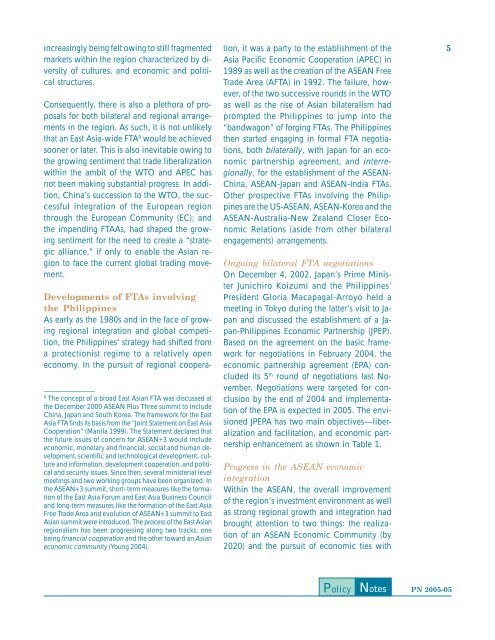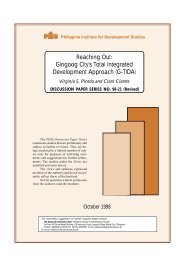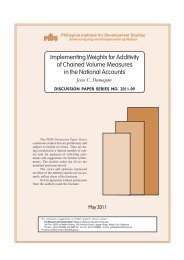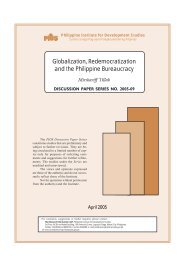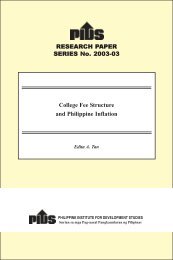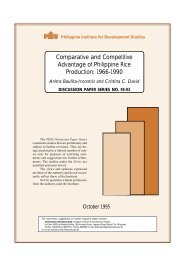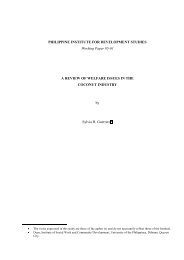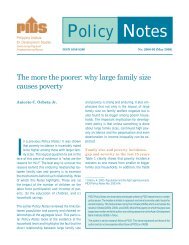What's Happening in the Philippine Free Trade Agreements?
What's Happening in the Philippine Free Trade Agreements?
What's Happening in the Philippine Free Trade Agreements?
Create successful ePaper yourself
Turn your PDF publications into a flip-book with our unique Google optimized e-Paper software.
<strong>in</strong>creas<strong>in</strong>gly be<strong>in</strong>g felt ow<strong>in</strong>g to still fragmentedmarkets with<strong>in</strong> <strong>the</strong> region characterized by diversityof cultures, and economic and politicalstructures.Consequently, <strong>the</strong>re is also a plethora of proposalsfor both bilateral and regional arrangements<strong>in</strong> <strong>the</strong> region. As such, it is not unlikelythat an East Asia-wide FTA 8 would be achievedsooner or later. This is also <strong>in</strong>evitable ow<strong>in</strong>g to<strong>the</strong> grow<strong>in</strong>g sentiment that trade liberalizationwith<strong>in</strong> <strong>the</strong> ambit of <strong>the</strong> WTO and APEC hasnot been mak<strong>in</strong>g substantial progress. In addition,Ch<strong>in</strong>a’s succession to <strong>the</strong> WTO, <strong>the</strong> successful<strong>in</strong>tegration of <strong>the</strong> European regionthrough <strong>the</strong> European Community (EC); and<strong>the</strong> impend<strong>in</strong>g FTAAs, had shaped <strong>the</strong> grow<strong>in</strong>gsentiment for <strong>the</strong> need to create a “strategicalliance,” if only to enable <strong>the</strong> Asian regionto face <strong>the</strong> current global trad<strong>in</strong>g movement.______________8The concept of a broad East Asian FTA was discussed at<strong>the</strong> December 2000 ASEAN Plus Three summit to <strong>in</strong>cludeCh<strong>in</strong>a, Japan and South Korea. The framework for <strong>the</strong> EastAsia FTA f<strong>in</strong>ds its basis from <strong>the</strong> “Jo<strong>in</strong>t Statement on East AsiaCooperation” (Manila 1999). The Statement declared that<strong>the</strong> future issues of concern for ASEAN+3 would <strong>in</strong>cludeeconomic, monetary and f<strong>in</strong>ancial, social and human development,scientific and technological development, cultureand <strong>in</strong>formation, development cooperation, and politicaland security issues. S<strong>in</strong>ce <strong>the</strong>n, several m<strong>in</strong>isterial levelmeet<strong>in</strong>gs and two work<strong>in</strong>g groups have been organized. In<strong>the</strong> ASEAN+3 summit, short- term measures like <strong>the</strong> formationof <strong>the</strong> East Asia Forum and East Asia Bus<strong>in</strong>ess Counciland long-term measures like <strong>the</strong> formation of <strong>the</strong> East Asia<strong>Free</strong> <strong>Trade</strong> Area and evolution of ASEAN+3 summit to EastAsian summit were <strong>in</strong>troduced. The process of <strong>the</strong> East Asianregionalism has been progress<strong>in</strong>g along two tracks, onebe<strong>in</strong>g f<strong>in</strong>ancial cooperation and <strong>the</strong> o<strong>the</strong>r toward an Asianeconomic community (Young 2004).Developments of FTAs <strong>in</strong>volv<strong>in</strong>g<strong>the</strong> Philipp<strong>in</strong>esAs early as <strong>the</strong> 1980s and <strong>in</strong> <strong>the</strong> face of grow<strong>in</strong>gregional <strong>in</strong>tegration and global competition,<strong>the</strong> Philipp<strong>in</strong>es’ strategy had shifted froma protectionist regime to a relatively openeconomy. In <strong>the</strong> pursuit of regional cooperation,it was a party to <strong>the</strong> establishment of <strong>the</strong>Asia Pacific Economic Cooperation (APEC) <strong>in</strong>1989 as well as <strong>the</strong> creation of <strong>the</strong> ASEAN <strong>Free</strong><strong>Trade</strong> Area (AFTA) <strong>in</strong> 1992. The failure, however,of <strong>the</strong> two successive rounds <strong>in</strong> <strong>the</strong> WTOas well as <strong>the</strong> rise of Asian bilateralism hadprompted <strong>the</strong> Philipp<strong>in</strong>es to jump <strong>in</strong>to <strong>the</strong>“bandwagon” of forg<strong>in</strong>g FTAs. The Philipp<strong>in</strong>es<strong>the</strong>n started engag<strong>in</strong>g <strong>in</strong> formal FTA negotiations,both bilaterally, with Japan for an economicpartnership agreement, and <strong>in</strong>terregionally,for <strong>the</strong> establishment of <strong>the</strong> ASEAN-Ch<strong>in</strong>a, ASEAN-Japan and ASEAN-India FTAs.O<strong>the</strong>r prospective FTAs <strong>in</strong>volv<strong>in</strong>g <strong>the</strong> Philipp<strong>in</strong>esare <strong>the</strong> US-ASEAN, ASEAN-Korea and <strong>the</strong>ASEAN-Australia-New Zealand Closer EconomicRelations (aside from o<strong>the</strong>r bilateralengagements) arrangements.Ongo<strong>in</strong>g bilateral FTA negotiationsOn December 4, 2002, Japan’s Prime M<strong>in</strong>isterJunichiro Koizumi and <strong>the</strong> Philipp<strong>in</strong>es’President Gloria Macapagal-Arroyo held ameet<strong>in</strong>g <strong>in</strong> Tokyo dur<strong>in</strong>g <strong>the</strong> latter’s visit to Japanand discussed <strong>the</strong> establishment of a Japan-Philipp<strong>in</strong>esEconomic Partnership (JPEP).Based on <strong>the</strong> agreement on <strong>the</strong> basic frameworkfor negotiations <strong>in</strong> February 2004, <strong>the</strong>economic partnership agreement (EPA) concludedits 5 th round of negotiations last November.Negotiations were targeted for conclusionby <strong>the</strong> end of 2004 and implementationof <strong>the</strong> EPA is expected <strong>in</strong> 2005. The envisionedJPEPA has two ma<strong>in</strong> objectives—liberalizationand facilitation, and economic partnershipenhancement as shown <strong>in</strong> Table 1.Progress <strong>in</strong> <strong>the</strong> ASEAN economic<strong>in</strong>tegrationWith<strong>in</strong> <strong>the</strong> ASEAN, <strong>the</strong> overall improvementof <strong>the</strong> region’s <strong>in</strong>vestment environment as wellas strong regional growth and <strong>in</strong>tegration hadbrought attention to two th<strong>in</strong>gs: <strong>the</strong> realizationof an ASEAN Economic Community (by2020) and <strong>the</strong> pursuit of economic ties with5PolicyNotesPN 2005-05


